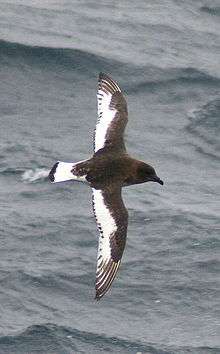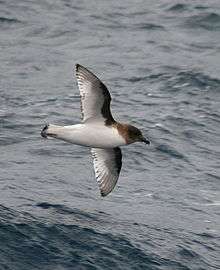Antarctic petrel
| Antarctic petrel | |
|---|---|
.jpg) | |
| Scientific classification | |
| Kingdom: | Animalia |
| Phylum: | Chordata |
| Class: | Aves |
| Order: | Procellariiformes |
| Family: | Procellariidae |
| Genus: | Thalassoica L. Reichenbach, 1853 |
| Species: | T. antarctica |
| Binomial name | |
| Thalassoica antarctica (J. F. Gmelin 1789)[2] | |


The Antarctic petrel (Thalassoica antarctica) is a boldly marked dark brown and white petrel, found in Antarctica, most commonly in the Ross and Weddell seas. They eat Antarctic krill, fish, and small squid. They feed while swimming but can dive from both the surface and the air.[3]
Taxonomy
The Antarctic petrel is the only known species in the genus Thalassoica, and is a member of the Procellariidae family, and the Procellariiformes order. Also, this petrel along with the snow petrel, the Cape petrel, both giant petrels, and the two species in the Fulmarus family, are considered to be a separate group from the other Procellariidae members.[4] They share certain identifying features. First, they have nasal passages that attach to the upper bill called naricorns. Although the nostrils on the petrels are on the top of the upper bill. The bills of Procellariiformes are also unique in that they are split into between seven and nine horny plates. On petrels, one of these plates forms the hooked portion of the upper bill. They produce a stomach oil made up of wax esters and triglycerides that is stored in the proventriculus. This can be sprayed out of their mouths as a defence against predators and as an energy rich food source for chicks and for the adults during their long flights.[5] Finally, they also have a salt gland that is situated above the nasal passage and helps desalinate their bodies, due to the high amount of ocean water that they imbibe. It excretes a high saline solution from their nose.[6]
Etymology
The word petrel is derived from St. Peter and the story of his walking on water. This is in reference to the petrel's habit of appearing to run on the water to take off.[7]
Description
The adult Antarctic petrel has a brown head, sides, throat, and back. Their bill is black and their feet are yellow. Their underparts are white and their tail and secondaries on their wings are white with brown tips.[8]
Range and habitat
The Antarctic petrel, as its name implies, lives and breeds in the Southern Ocean, and on the Antarctic islands.[9]
Conservation
This petrel has an occurrence range of 35,200,000 km2 (13,590,796 sq mi) and between 10 and 20 million adult birds based on a 2009 estimate. With these numbers and the large range, this bird has been classified as least concern, by the IUCN.[1][10]
Footnotes
- 1 2 BirdLife International (2012). "Thalassoica antarctica". IUCN Red List of Threatened Species. Version 2013.2. International Union for Conservation of Nature. Retrieved 26 November 2013.
- ↑ BirdLife International (2009a)
- ↑ ZipCode Zoo (16 Jul 2009)
- ↑ Tree of Life (27 Jun 2008)
- ↑ Double, M. C. (2003)
- ↑ Ehrlich, Paul R. (1988)
- ↑ Gotch, A. T. (1995)
- ↑ ZipCode Zoo (19 Jun 2009)
- ↑ Clements, James (2007)
- ↑ BirdLife International (2009)
References
- BirdLife International (2009). "Antarctic Petrel Thalassoica antarctica - BirdLife Species Factsheet". Data Zone. Retrieved 17 Jul 2009.
- BirdLife International (2009a). "The BirdLife checklist of the birds of the world, with conservation status and taxonomic sources." (xls). Retrieved 17 Jul 2009.
- Brands, Sheila (14 Aug 2008). "Systema Naturae 2000 / Classification - Genus Thalassoica-". Project: The Taxonomicon. Retrieved 22 Feb 2009.
- Clements, James (2007). The Clements Checklist of the Birds of the World (6th ed.). Ithaca, NY: Cornell University Press. ISBN 978-0-8014-4501-9.
- Double, M. C. (2003). "Procellariiformes (Tubenosed Seabirds)". In Hutchins, Michael; Jackson, Jerome A.; Bock, Walter J.; Olendorf, Donna. Grzimek's Animal Life Encyclopedia. 8, Birds I: Tinamous and Ratites to Hoatzins. Joseph E. Trumpey, Chief Scientific Illustrator (2nd ed.). Farmington Hills, MI: Gale Group. pp. 107–111. ISBN 0-7876-5784-0.
- Ehrlich, Paul R.; Dobkin, David, S.; Wheye, Darryl (1988). The Birders Handbook (First ed.). New York, NY: Simon & Schuster. pp. 29–31. ISBN 0-671-65989-8.
- Gotch, A. F. (1995) [1979]. "Albatrosses, Fulmars, Shearwaters, and Petrels". Latin Names Explained A Guide to the Scientific Classifications of Reptiles, Birds & Mammals. New York, NY: Facts on File. pp. 191–192. ISBN 0-8160-3377-3.
- Tree of Life (27 Jun 2008). "Procellariidae. Shearwaters, Petrels". Tree of Life Web Project. Archived from the original on 15 February 2009. Retrieved 18 Mar 2009.
- ZipCode Zoo (19 Jun 2009). "Thalassoica antarctica (Antarctic Fulmar)". BayScience Foundation. Retrieved 20 Jul 2009.
- ZipCode Zoo (16 Jul 2009). "Procellariinae (Subfamily)". BayScience Foundation. Archived from the original on 2012-06-09. Retrieved 20 Jul 2009.
